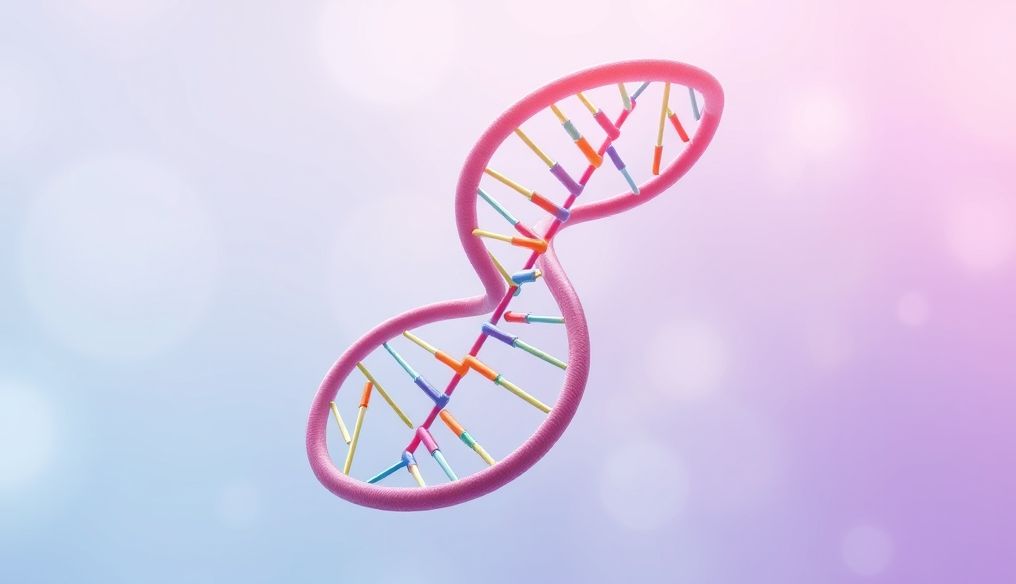What is DNA?
Deoxyribonucleic acid (DNA) is a complex molecule that carries the genetic instructions for the development, functioning, and reproduction of all known living organisms and many viruses. DNA serves as the "genetic blueprint" containing all the information that determines an organism's characteristics, from eye and hair color to predisposition to certain diseases.
DNA Structure
DNA is composed of subunits called nucleotides. Each nucleotide consists of three main parts:
- Nitrogenous base: Four main types: adenine (A), thymine (T), cytosine (C), and guanine (G).
- Deoxyribose sugar: A five-carbon sugar.
- Phosphate group: Attached to the deoxyribose sugar.
Nucleotides are linked together to form a long chain, and two DNA chains form a double helix. The nitrogenous bases pair specifically: adenine (A) always pairs with thymine (T), and cytosine (C) always pairs with guanine (G).
How Does DNA Determine Our Traits?
DNA is responsible for determining our genetic traits through a complex process involving genes and proteins. Here's how it works:
Genes: Units of Heredity
A gene is a segment of DNA that carries the instructions for producing a specific protein. Proteins are the molecular machines that perform most of the cell's functions, such as building tissues, transporting molecules, and catalyzing chemical reactions.
The Process of Gene Expression
The process of gene expression involves two main steps:
- Transcription: DNA is transcribed into an intermediate molecule called messenger RNA (mRNA).
- Translation: mRNA is used as a template to produce the protein.
The sequence of nitrogenous bases in the gene determines the sequence of amino acids in the resulting protein. This sequence, in turn, determines the shape and function of the protein.
Genetic Traits
Genetic traits result from the interaction between genes and the environment. Some traits, such as blood type, are determined by a single gene. Other traits, such as height and intelligence, are determined by the interaction of multiple genes and the environment.
The Importance of DNA in Health and Medicine
Understanding DNA is of great importance in the field of health and medicine. Here are some key applications:
Genetic Diagnosis
DNA tests can be used to diagnose genetic diseases, such as cystic fibrosis and Huntington's disease. They can also be used to identify the risk of developing certain diseases, such as breast cancer and Alzheimer's.
Gene Therapy
Gene therapy is a promising technique for treating genetic diseases by introducing healthy genes into the patient's cells. Gene therapy is still in its early stages, but it holds great potential for treating many diseases.
Personalized Medicine
DNA information can be used to determine the most effective drugs for each patient. This approach, known as personalized medicine, can improve treatment outcomes and reduce side effects.
DNA and Evolution
DNA plays a crucial role in the process of evolution. Mutations, which are changes in the DNA sequence, are the source of genetic variation. Natural selection acts on this variation, leading to the evolution of organisms over time.
Mutations
Mutations can be harmful, beneficial, or neutral. Harmful mutations can cause diseases. Beneficial mutations can increase an organism's ability to survive and reproduce. Neutral mutations have no effect on the organism.
Natural Selection
Natural selection is the process by which organisms with beneficial traits are more likely to survive and reproduce than organisms with less beneficial traits. Over time, natural selection can lead to the accumulation of beneficial mutations and the evolution of organisms.
DNA in Forensic Science
DNA is widely used in forensic science to identify individuals. DNA found in samples of blood, hair, saliva, and other tissues can be used to create a unique "genetic fingerprint" for each individual.
DNA Analysis
DNA analysis involves comparing the DNA found in a sample from a crime scene to the DNA of suspects. If the DNA matches, this indicates that the suspect was present at the crime scene.
DNA Databases
Many countries maintain DNA databases of convicted criminals. These databases can be used to match DNA found at crime scenes to known criminals.
Challenges and Ethics of Using DNA
Despite the many benefits of using DNA, there are also some challenges and ethics to consider:
Privacy
DNA information is highly sensitive and must be protected from unauthorized access. There are concerns about the use of DNA information to discriminate against individuals.
Informed Consent
Individuals must give informed consent before undergoing DNA testing. They should be aware of the potential risks and benefits of the test.
Justice
Access to DNA testing and gene therapy should be available to all individuals, regardless of their socioeconomic status.
The Future of DNA Research
DNA research is constantly evolving, and there are many promising areas for future research:
Gene Editing
Gene editing is a technique that allows scientists to precisely modify the DNA of living organisms. This technique holds great potential for treating genetic diseases and developing improved agricultural crops.
Functional Genomics
Functional genomics is the study of the functions of genes and proteins. This field helps us understand how DNA works and how it affects our health.
Epigenetics
Epigenetics is the study of heritable changes in gene expression that do not involve changes to the DNA sequence. These changes can affect gene expression and play a role in diseases.
In conclusion, DNA is a vital molecule that carries the genetic code that determines our traits. Understanding DNA is of great importance in the fields of health, medicine, forensic science, and evolution. As DNA research continues to evolve, we can expect to see even more discoveries and breakthroughs that will improve our lives.




